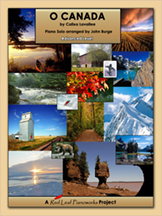O Canada [arranged for solo piano] (2016)
| Instrumentation: | Solo Piano |
| Genre: | Piano Music |
Duration: 2 Minutes
Note: This arrangement is included in the collection PIANO REFLECTIONS and is only available for purchase separately in PDF format.

IMMEDIATELY AFTER MAKING PAYMENT AN EMAIL WILL BE SENT TO THE PURCHASER WITH A LINK TO DOWNLOAD THE PDF. A SINGLE USER LICENSING AGREEMENT WILL BE SENT LATER, USUALLY WITHIN 24 HOURS.
Program Note: O CANADA was composed by Calixa Lavallée (1842-1891) in 1880. Although it was used as Canada’s national anthem for many decades, it was only officially recognized as such by an act of parliament in 1980 (one hundred years after the song was first published). There are numerous arrangements of this tune and one of John Burge’s favourite is by Godfrey Ridout with whom Burge studied counterpoint at the University of Toronto. Like many pianists, Burge has often found himself in situations where he has had to play “O Canada” on the piano and over the years his own arrangement has become quite stylized in a somewhat virtuosic fashion. He has also incorporated the study and analysis of this tune into many of his theory and analysis classes at Queen’s University, especially around the date of a federal election. During the year that Stephen Harper was first elected Prime Minister of Canada, Adèle Barclay, a student of one such class, summarized Burge’s treatment of the national anthem in the Literary Review of Canada (July/August 2015, p.9) while reviewing Brian Thompson’s biography of Calixa Lavellée (Anthems and Minstrel Shows: The Life and Times of Calixa Lavallée, McGill-Queen’s University Press, 2015):
During my first-year music theory course at Queen’s University, Professor John Burge demonstrated a particular harmonic sequence using the opening chords of “O Canada” as an example. The first three chords are a basic enough riff off Pachelbel’s Canon, but in “O Canada” their resolution is relaxed, making the familiar strong chords tentative—which is a curious construction for what is supposed to be a patriotic march. Anthems typically boast at the onset, pursuing unflinching triumph rather than coy lyricism. Burge pointed out that this particular harmonic design dovetails with the unassuming Canadian identity. He suggested that this coincidence was possibly due to intuition of the part of the composer or, perhaps, that this inaugural delicate pathos appealed to later generations when they adopted “O Canada” as our national anthem.
Burge timed the lesson to fall on an election day and interrupted the class to answer a fake phone call from Prime Minister Paul Martin—the purpose of which was to inspire the class, predominantly 18-year-olds, to vote for the first time. After hanging up the phone, Burge launched into a full-fledged performance of “O Canada” on the grand piano. The music majors sang with their practiced voices a compelling and impromptu rendition of the national anthem. Burge’s performance was a lesson on the relationship between music and nationalism.
This arrangement is dedicated to Mary and Peter Burns. Mary was John’s harmony, counterpoint and analysis teacher when he was growing up in Calgary and she was certainly a great help in completing all of the requirements for the Associate Diploma of the Royal Conservatory of Music while he was still in high school. A fine pianist herself, Mary was in demand as an accompanist and kindly played the orchestral reduction for a number of piano concertos that John learned at the time. Successful arrangements of existing tunes often rely heavily on harmony and counter-point and as such, this particular dedication seems very fitting.